A good start: Literary stroll along Drottninggatan part 1. From Norrtullsgatan to Kungsgatan. Elin Wägner, Strindberg and more
- A good start: Literary stroll along Drottninggatan part 1. From Norrtullsgatan to Kungsgatan. Elin Wägner, Strindberg and more
- Stop 1. Gamla Brogatan intersection. PUB, the rebels Lenin and Anckarström
- Stop 2. The mouth of Gamla Brogatan. Mordens gata.
- Stop 3. Drottninggatan 59. Ugglan Pharmacy.
- Stop 4. Bryggargatan mouth. Terrorists, Zorn and Dan Andersson.
- Stop 5. Mäster Samuelsgatan / Sergels torg. A gutter and a snobbery gutter then, a gutter for common people now.
- Stop 6. Drottningatan / Brunkebergsgatan down towards Klarakvarteren.
- Stop 7. Around Klara Church.
- Stop 8. Karduansmakargatan intersection. Palace oasis in the stone desert.
- Stop 9. Fredsgatan from Rosenbad to Gustav Adolfs torg
- Stop 10. Fredsgatan towards Gustv Adolfs torg.
- Stop 11. Fredsgatan 5, back side UD / Hereditary Prince’s Palace.
- Stop 12. Gustaf Adolfs torg Kastenhov/Rydberg
- Stop 13. Gustav Adolfs torg with opera and soap opera
Start the walk from the intersection of Kungsgatan – Drottninggatan.
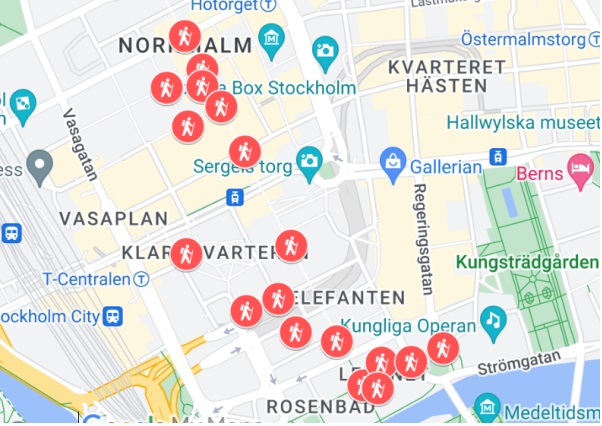
Stop 1. Gamla Brogatan intersection. PUB, the rebels Lenin and Anckarström
Former PUB Drottninggatan / Kungsgatan. Young Västgötänkaknall Paul Bergström sold ready-made with such success that he bought half and then the entire block between Hötorget and Drottninggatan.
1925. Paul Bergström opens PUB with a light courtyard and a Hötorg facade that matches the Concert House’s style ideal. Paul’s son Kristian gets his beard soaped at Ekengren’s barbershop by a girl who is quickly hired in the PUB’s hat department. There Greta Gustafsson makes an extra appearance as a model and also in a commercial for the cinemas. She is discovered, Gustavsson becomes Garbo.
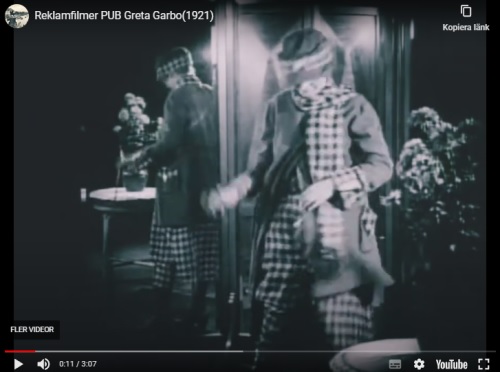
Olof Palme got help buying shoes at PUB, then owned by the cooperative. He wanted six comfortable pairs of the same type, but the clerk advised him to settle for three.

April 1917. Lenin was poorly dressed when he rested at the Hotel Regina during his return trip to Russia. Swedish socialist hosts made him buy a suit at PUB for 100 kronor. The clerk’s great-grandson has told . Another anecdote says that it was the bookbinder Nils Björkman who was responsible for the purchase. The body was suitable as a mannequin for the purchase of the suit and a coat with a velvet collar. A third anecdote says that Lenin refused to buy the coat because, as he said: ”I am going to Russia to make a revolution, not to open a men’s clothing store”.

Stop 2. The mouth of Gamla Brogatan. Mordens gata.
Gamla Brogatan was called Kungsholmsbrogatan before it was crushed by the railway. This meant that the place where Bellman lived and died in 1795 disappeared. The bridge to Kungsholmen had to be moved and become part of Kungsgatan. In contrast to the lavish Sergels torg, Gamla Brogatan has retained its character from previous centuries.
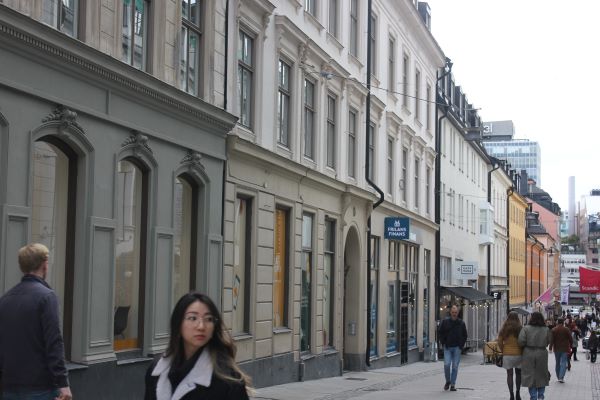
1792. Before the regicide , newly arrived Johan Jacob Anckarström rented a room two flights of stairs up the farm house with an attached barn. The address was Gamla Brogatan (Kungsholmsbrogatan) 9, near Målargränd . He borrowed money from his neighbor Carl Fredrik Horn. During a dinner, the king-haters Anckarströn and Adolph Ribbing hatched the murder plan. (The Ribbing family is said to have lived on Drottninggatan. As the widow of Fredrik Ribbing, the home of Adolph’s mother Eva Löwen became a place where the king’s acolytes gathered).
Stop 3. Drottninggatan 59. Ugglan Pharmacy.
November 30, 1868. “You boys go ahead, I’ll come after you later.” With those words, August Blanche stumbles into the Ugglan pharmacy. He sinks down on a sofa, feeling sick. After a few minutes, he has a stroke and dies in the pharmacist’s arms.
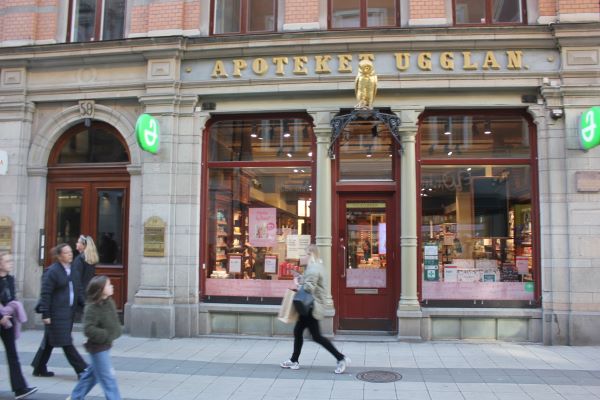
The students have arrived by train and are gathering at the Hotel Fenix, near Norra Latin. There they meet Blanche who is having breakfast before he is to speak at the unveiling of the statue of Charles XII in Kungsträdgården. The popular author is deeply concerned that three stands will shut out ordinary people. But Charles XV did not want to listen to Blanche’s call to tear down one of these. The radical press has fueled the anger.
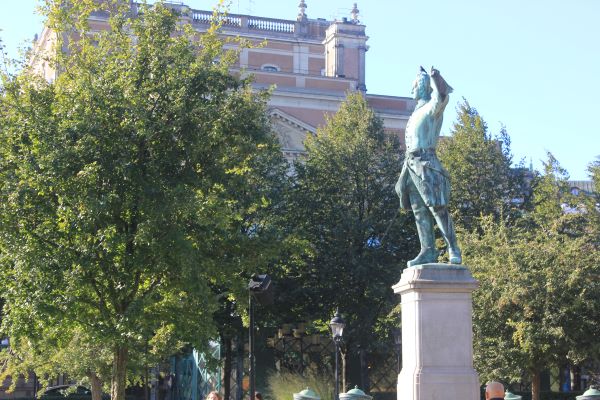
From Fenix, the author marches under banners in the student procession down Drottninggatan. After Ugglan, the young people continue without Blanche. Riots break out outside the stands and many are injured by the military. Lifeguards with sabres cut their way through the crowd. A rumor spreads in the audience that Blanche is dead.
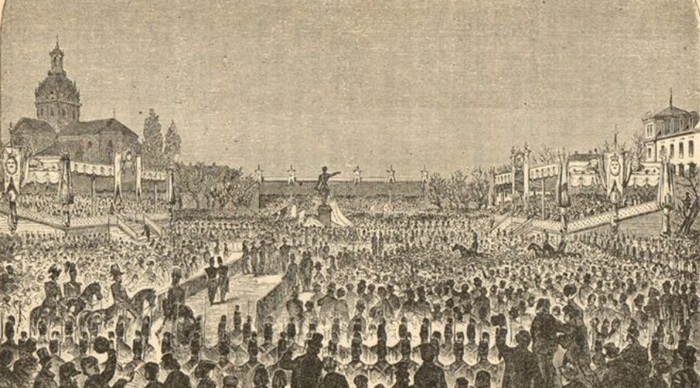
Large crowds follow the funeral procession to the New (Northern) Cemetery.
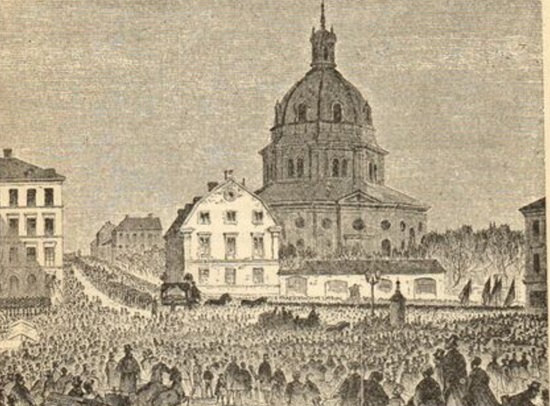
Stop 4. Bryggargatan mouth. Terrorists, Zorn and Dan Andersson.
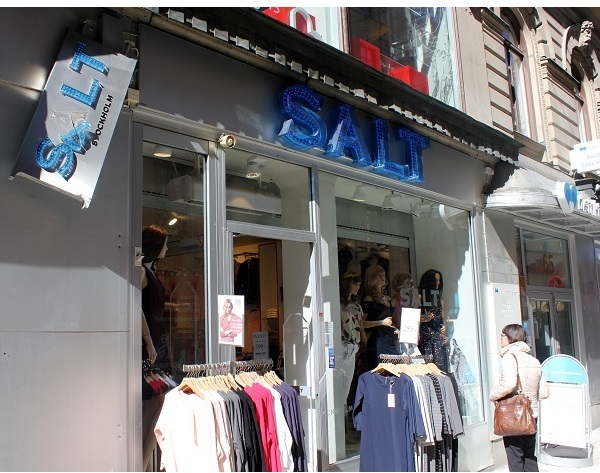
Drottninggatan 66. People rush through the door of the clothing store Salt on Drottninggatan. Seconds later, the truck sweeps away the clothing rack and the store sign. A concrete lion is pushed along the street into a store window. We remember the video from the surveillance camera where Akilov passes by with the brewer’s truck on this April day in 2016.
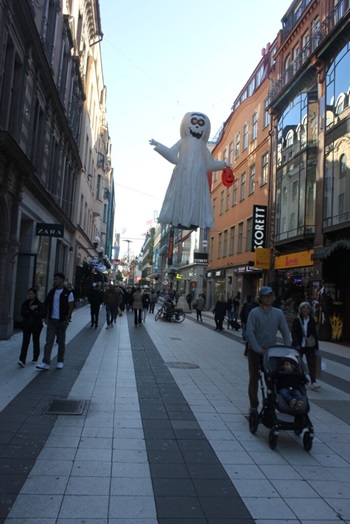
Drottninggatan 55. On the other side of the street, at Scorett a few steps into Bryggargatan, Abdulwahab blew himself up in a terrorist attack in 2009.
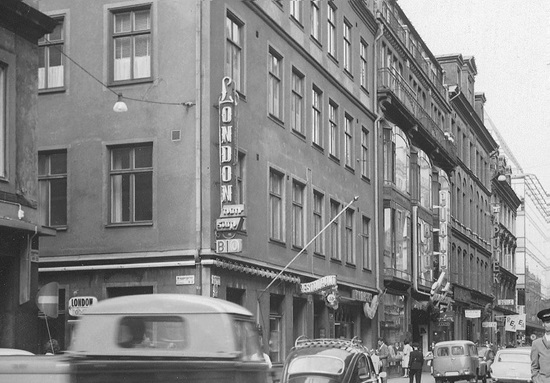
After the skittles game every Tuesday, Zorn gathered his comrades in the restaurant. This Order of St. Clotilda included faithful drinking brothers Carl Larsson, Albert Engström and Karlfeldt.
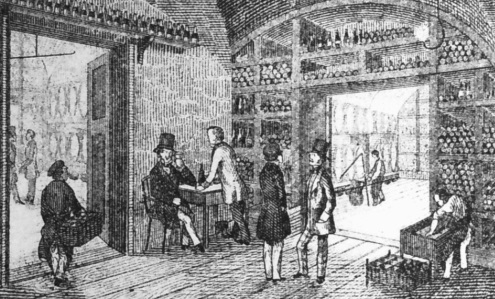
Bryggargatan 5. On Bryggargatan was the Hellman Hotel , where Dan Andersson used to stay for cheap money . He died there one night in 1920, poisoned by hydrogen cyanide used against bedbugs.
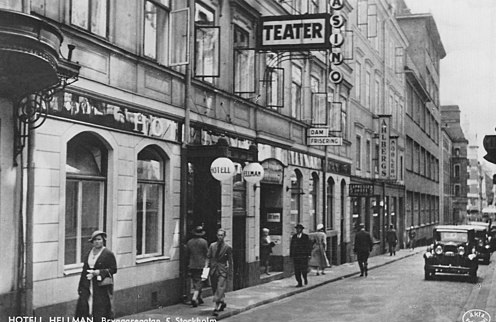
Bryggargatan 12. Dan Andersson was an inspiration for Harry Martinsson. After the divorce, he hid from Moa at the cheap Hotel Savoy .

Stop 5. Mäster Samuelsgatan / Sergels torg. A gutter and a snobbery gutter then, a gutter for common people now.
2016. Rakhmat Akilov managed to kill five and injure even more before ramming the Åhléns storefront at the Drottninggatan / Mäster Samuelsgatan intersection. The last victim was Ebba Åkerlund who was crossing the pedestrian crossing at Åhléns from Mäster Samuelsgatan.
Drottninggatan 56. Emilie Flygare Carlén lets a lovesick chamberlain Lassman live in the one-room apartment on the same corner. The book Chamberlain Lassman from 1842 is worth reading.
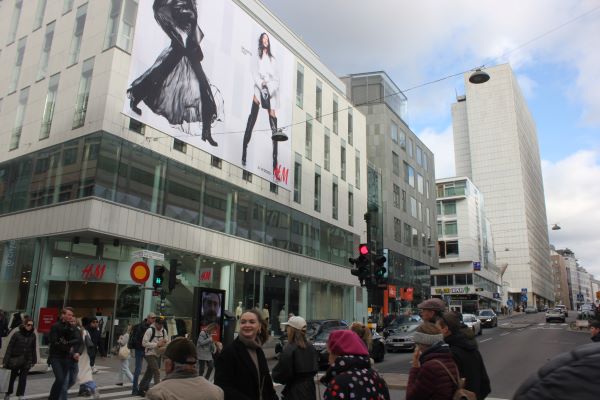
Between Hötorget and Mäster Samuelsgatan was the Beridarebanan, a hall for horse dressage and jousting. Queen Christina arrived there, drawn by a six-horse team, for her coronation in 1650.
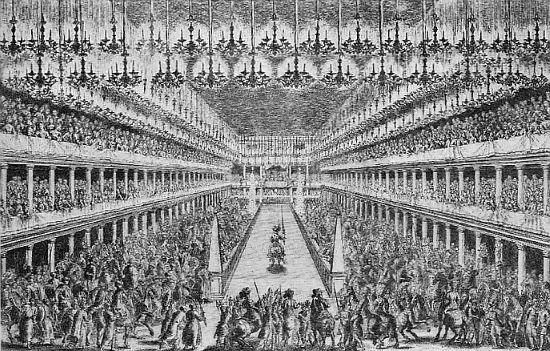
Sergels torg. The railway attracted newspaper printing houses, restaurants and hotels to Norrmalm. The most elegant was the Hotel de Suede on the corner of Drottninggatan and Klarabergsgatan, where diplomats were happy to stay. Built in 1851 and chewed up by the excavators in 1952. The same Norrmalm regulation affected the Hotel Regina on the other side of Drottninggatan – where we now see the subway’s glass building on Sergels torg.
Regina is most famous for its bowling alley. And for having hosted Lenin and his traveling companions in April 1917, on their way from exile in Switzerland to make a revolution in Petrograd (renamed from Saint Petersburg).
Lenin wanted to make a revolution but Branting did not want it. The socialists split that year into social democrats and communists, the latter formed by Ture Nerman and Zeth Höglund.
Lenin’s host in Stockholm was the red writer Ture Nerman , who in literary contexts was close to Hjalmar Söderberg and Elin Wägner. Lenin wanted to meet Höglund, but he was then staying on Långholmen.
From Stockholm, Lenin’s passengers took the train north. Perhaps Lenin’s and Branting’s trains met up near Haparanda, as the latter was on his way home from Petrograd during the February Revolution.
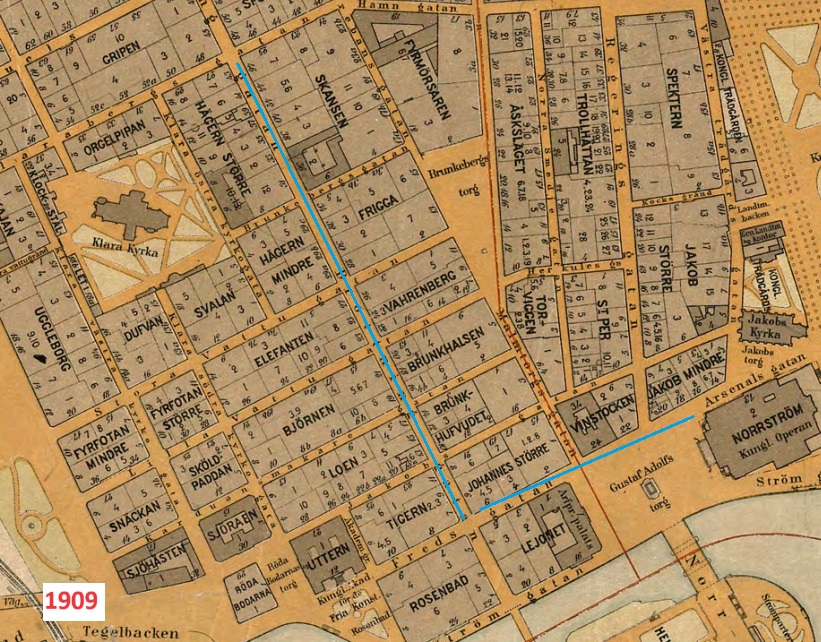
Stop 6. Drottningatan / Brunkebergsgatan down towards Klarakvarteren.
Drottninggatan 32. Gma p GmapSt r
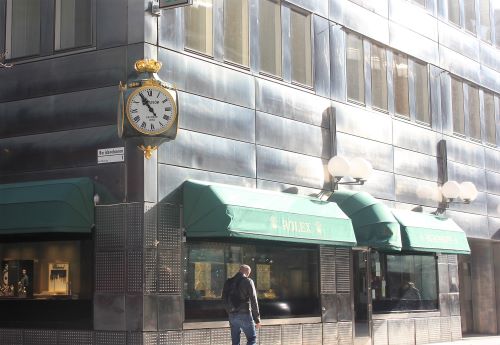
After passing the Kulturhuset, you can see one on the corner towards the alley Beridarbana. As a reminder of the Linderoth watch factory that used to be here.

Per Wästberg’s mournful text in A Corner Tower on Riddargatan : ” You search in vain for the familiar shops, and suddenly a friend’s house is vacated or razed to the ground. But a city is not a museum. In homes and shops, in hotels and offices, it is the last season of Klara – Stockholm’s biggest spectacle in centuries. Whether the future Klara will live on as a concept we do not know.”

Stop 7. Around Klara Church.
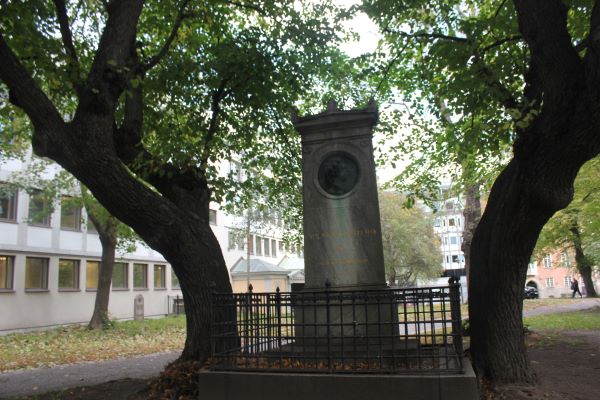
The detour down Brunkebergsgatan leads to Klara Church with Michael Bellman’s grave. In the yellow lane to the north was Klara School, or the trivial school as it was called in 1647. As August Blanche wrote about in his novels. Strindberg disliked the school. From The Servant’s Son:
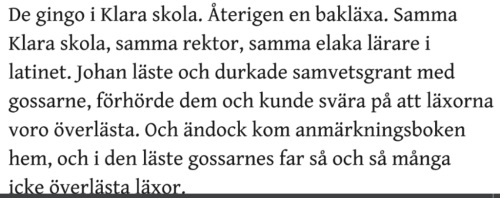
Lille August had a short way to school for the family lived on Klara Västra Kyrkogata. A newspaper street thanks to the short distance to the railway. Dagens Nyheter left Riddarholmen for Västra Kyrkogatan, number six on the old map. Aftonbladet from Gamla stan to number seven. Stockholms Dagblad to the corner towards Lilla Vattugatan.
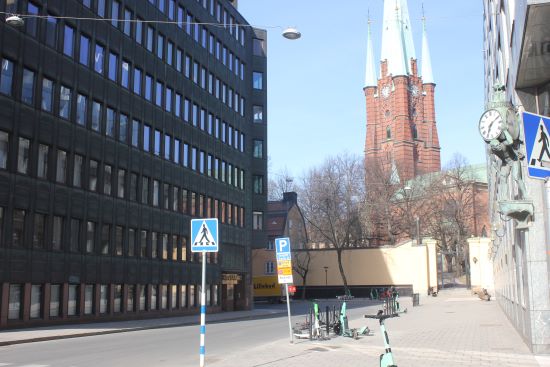
1917. Vladimir Lenin’s morning-tired party left the Central Station and hurried through Vattugatan. Lenin knew the neighborhood. He and Stalin attended the Socialist World Congress in 1906 in the People’s House at Bantorget. Stalin, (who would later kill most of Lenin’s party), lived in the shabby Bristol. Before its demolition, the hotel was located on Klara Östra Kyrkogata, near the cemetery corner.
On dreary Vattugatan, outside number 8, you can recall the memory of Tennstopet , in the murmur of journalists and poetry-writing Klarabohemians .
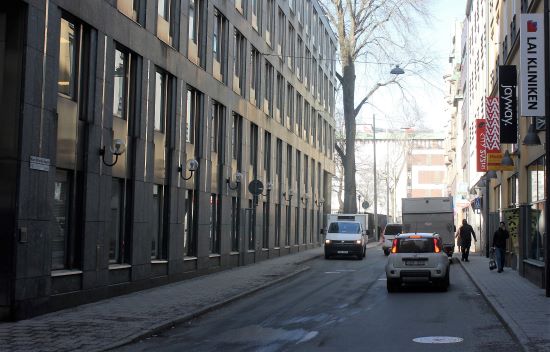
Stop 8. Karduansmakargatan intersection. Palace oasis in the stone desert.
The city’s snobbish scene moved from Norrbro to lower Drottninggatan in the second half of the 19th century, just as crowded as a Saturday today. Sugar bakers and Swiss bakers lined the street. Those less fortunate bought pastries from old women who had small stalls on street corners.

A ragtag group if you can believe Elin Wägner’s Norrtullsligan: ”I walked up Drottninggatan and was molested six times between Fredsgatan and Kungsgatan by Stockholm’s heroes and knights. The sixth was the boss, but he thought he was excellent and said that he recognized me from afar . ”
The former bank building at Drottninggatan 17 , corner of Karduansmakargatan, has been taken over by the Government Offices. The ornamented portal in the Art Nouveau facade leads to the Dance Museum . Anyone who wanders there digitally will experience a lot of dance history.
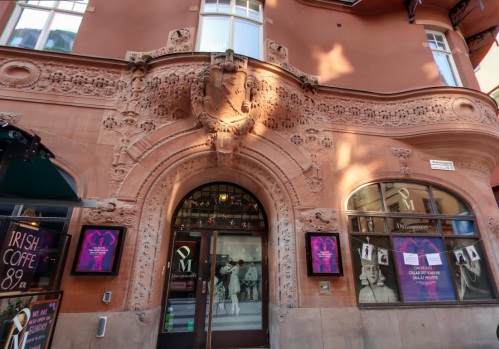
Not many people dare to walk on Karduansmakargatan on a dark night. Dreary shantytowns, never mind that the corner house at Drottninggatan 14 is the city’s first functionalist building. But in the other direction lies a gem: the Adelcrantzka Palace at Karduansmakargatan 8, a solitary survivor of the Norrmalm demolition.
- Adelcrantz palats.
- Adelcrantzka Palace 1759. Sandwiched against the house where Svenska Dagbladet was located in its early years. Later at 11B.
1750s . After the Klarabranden fire, Carl Fredrik Adelcrantz built the house at Karduansmakargatan 8. The interior designer of the time with the Gustavian Opera House as his main merit. The money was not enough, a General de la Gardie expanded. Followed by a series of owners, most recently the Government Offices. Click to the source Wikipedia
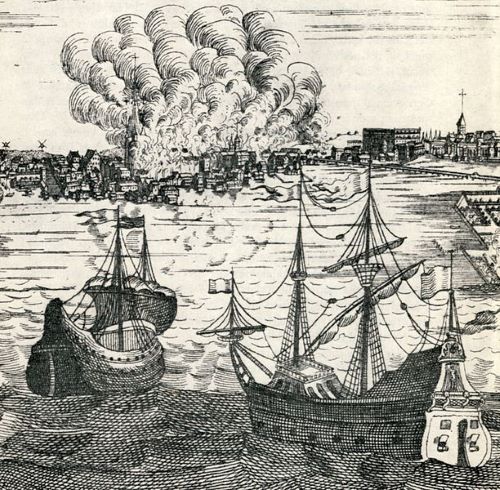
The demolitions of the residences of power around here seem just as devastating as when the fire reduced the neighborhoods along Klara Sjö to ashes, from Norrström to Apelbergsgatan.
- Drottninggatan south, Vattugatan on the right.
- Drottninggatan 13-15, north from Jakobsgatan. 1964.

Stop 9. Fredsgatan from Rosenbad to Gustav Adolfs torg
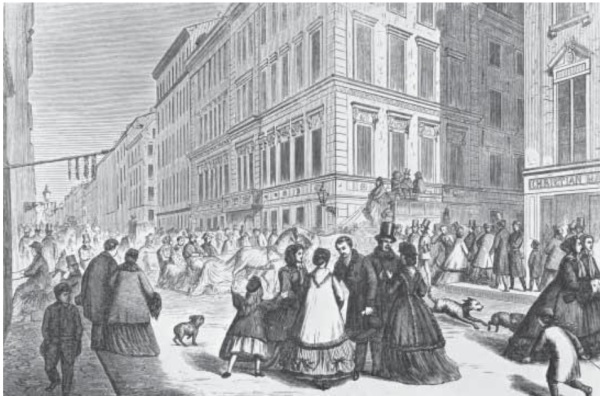
Drottninggatan / Fredsgatan . On the corner of Drottninggatan 6, for a few decades around the middle of the 18th century, there was the wine cellar Kejsrkronan , the ancestral home of Bellman and his brothers. On the opposite corner, number 5, Crown Prince Bernadotte’s immigrant court confectioner Scheutz opened a Swiss bakery, later in competition with the immigrant Jew Abraham Behrens ’ Swiss bakery on Drottninggatan 6. The sugar bakers complained that the guild regulations did not allow the serving of better pastries and spirits as in the coffee shops called Swiss bakeries.
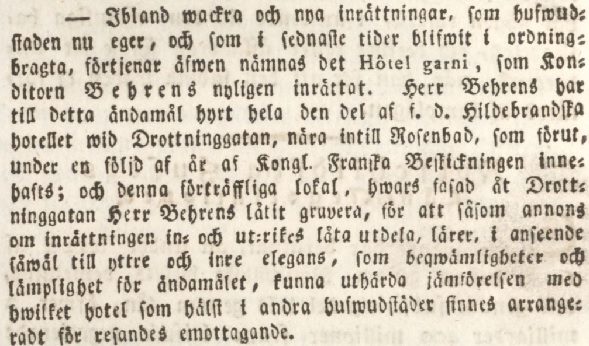
1832. Behrens had a good reputation and was able to open the doors of the Hotel Garni at Drottniggatan 3 in one of the Hildebrandska houses in the Rosenbad district. It was considered the first hotel for the better class in Stockholm. Shops and places to eat contributed to southern Drottninggatan becoming the Strandvägen of its time.
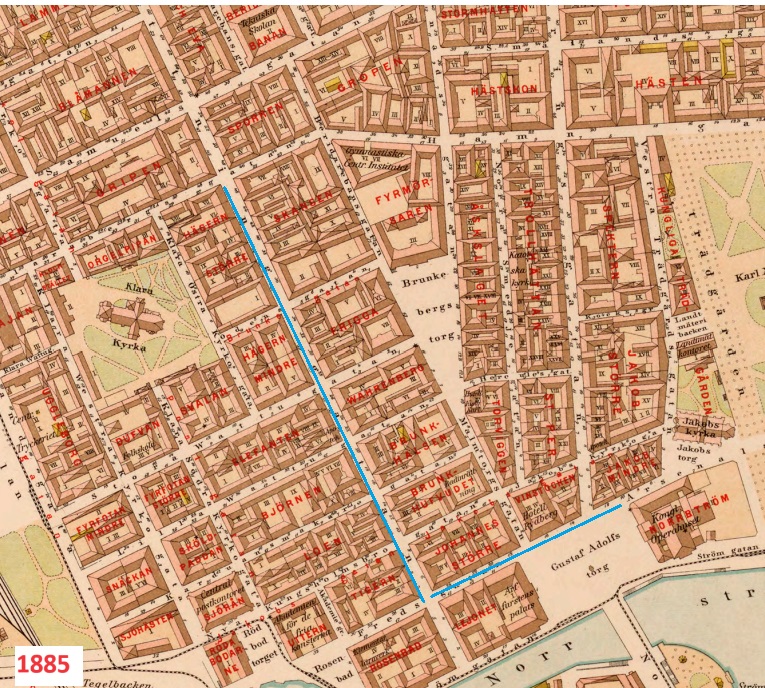
1860. Goldsmith CG Hallbergs had a business acumen and started trading on the corner of Drottninggatan 6 / Fredsgatan. Here the chain is known as Hallbergs Guld.
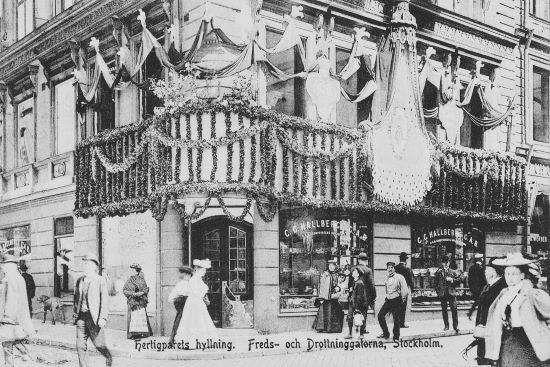
Stop 10. Fredsgatan towards Gustv Adolfs torg.
Fredsgatan 4. The house was built for Sundsvallsbanken at the turn of the last century. Archbishop Nathan Söderblom was a young priest in Paris when he was the model for the figure that adorns the gate. There, Söderblom led a fundraiser so that August Strindberg received medical treatment for his wounded alchemist hands. Today, the house houses a press room for the Ministry of Foreign Affairs.

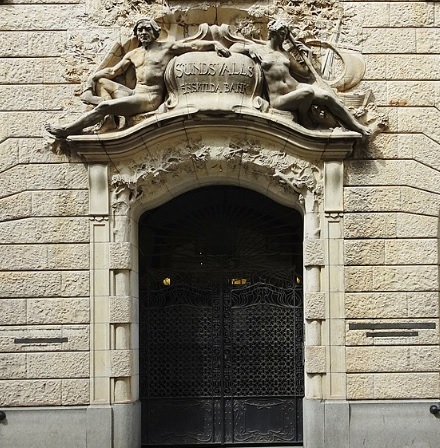
Fredsgatan 2. The Mediterranean Museum on the corner of Malmtorgsgatan. Gustav VI Adolf contributed to the collections there.
Henrik Palme founded the Mortgage Bank with headquarters built on the site of the burned-down Hornska Palace . Built during Queen Christina’s reign by Field Marshal Gustav Horn . Remains can be found in the walls of the building, which houses parts of the government offices and since 1982 the Mediterranean Museum.
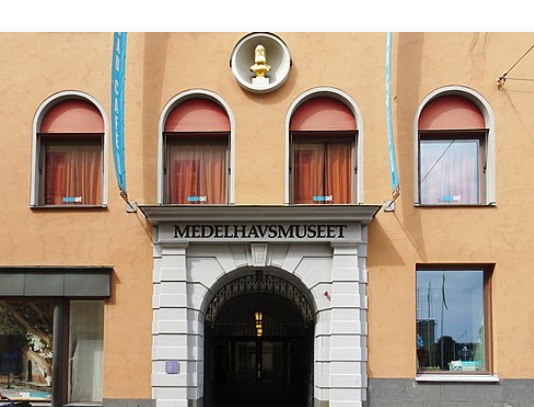
Henriks Palme’s bust sits above the gate. Henriks younger brother Sven was the father of Olof and Gunnar Palme. The historian Olof Palme fell for the Whites in the Finnish Civil War, as an organizer of volunteers in the Swedish Brigade. Perhaps a tribute to him that prompted the insurance director Gunnar Palme to name his son Olof, later Prime Minister.
- The Hornska Palace was called the Pallinska House when nine people died in the flames in November 1873.
Stop 11. Fredsgatan 5, back side UD / Hereditary Prince’s Palace.
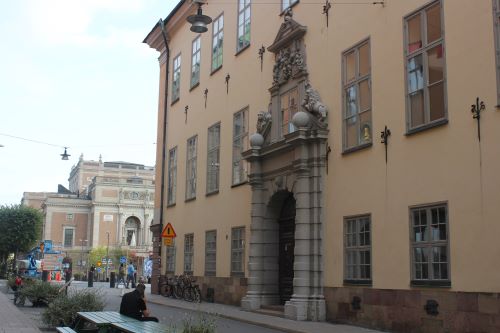
Gustav III’s sister Sophia Albertina bought the Torstensonska Palace on Fredsgatan and expanded towards the square and Strömmen, after her donation known as the Arvfurstens Palace , seat of the Ministry of Foreign Affairs. The facade facing Fredsgatan shows the palace characterized by the Renaissance when built in 1640. The name Fredsgatan probably alludes to the peace after the Thirty Years’ War, where the general Lennart Torstenson became a war hero with the battle of Breitenfeld .
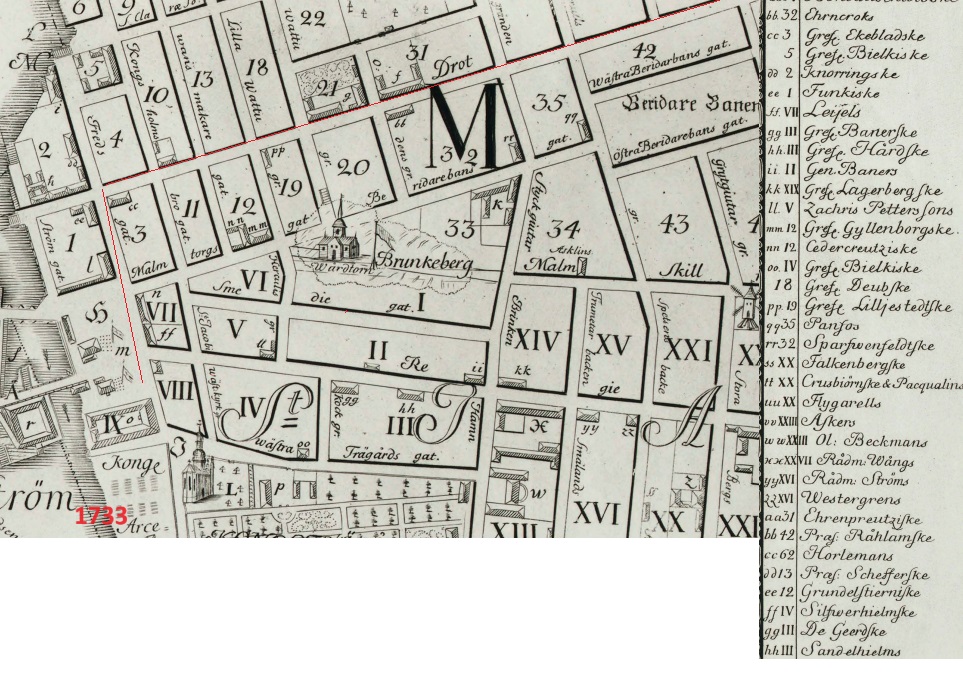
Stop 12. Gustaf Adolfs torg Kastenhov/Rydberg
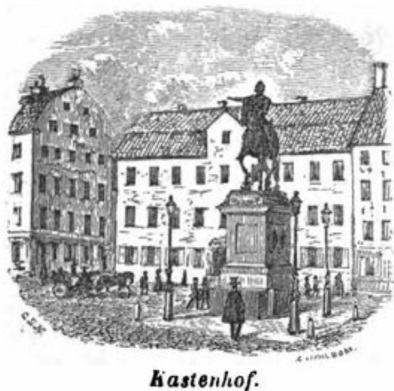
Kastenhof corner towards Malmtorgsgatan. Where until the 19th century you could enjoy a glass of wine in the inn under the portrait of Queen Christina’s cupbearer Kasten Hof . And be fined in the same cellar and then be sentenced in the back of the house in the magistrate’s court , the city’s lowest court.
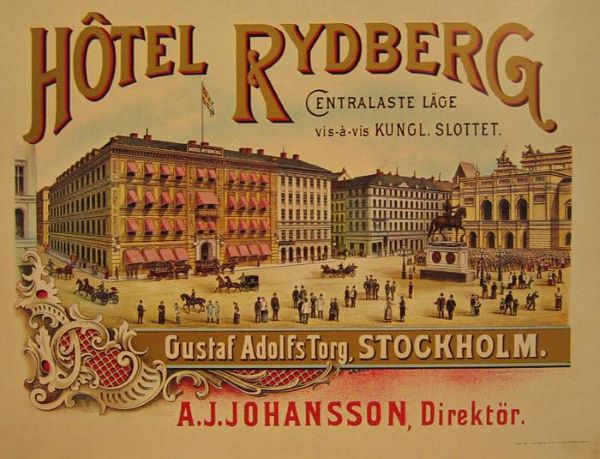
1850s. Kastenhov is demolished and a shipowner Rydberg invests money in the construction of Hotel Rydberg , the city’s hotel above others. Anders Zorn lives here and perhaps eats a Biff Rydberg . In the bar together with the cultural elite, enjoying pilsner and brandy. Friends Albert Engström, Carl Larsson and Hjalmar Söderberg are often guests.
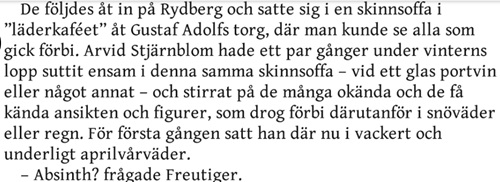
1914. The hotel is demolished to make way for the Scandinavian Bank’s monument to capital until 1960, with the move to Sveavägen.
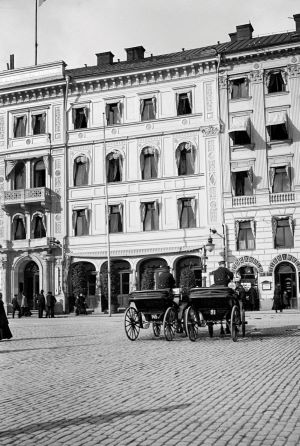
Stop 13. Gustav Adolfs torg with opera and soap opera
The love affairs benefited Fredrica Löv’s career as an actress in Bollhuset and at the newly founded Dramaten. Luxury waste according to some. Two children with Prince Adolf Fredrik , together with both Johan Henrik Kellgren and Tobias Sergel . So profitable that she kept an apartment at Gustav Adolfs torg diagonally opposite the Gustavianska opera. With silk-covered furniture, her own servants and her own carriage on the street.
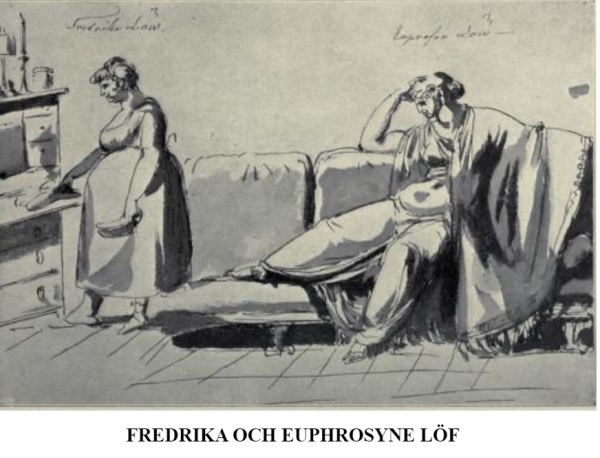
The poet Johan Henrik Kellgren has a grave and a memorial plaque at Jacob’s Church. Patron Gustav III had Kellgren write the opera Gustav Wasa . It premiered in 1786 in the newly built Gustavian Opera House .
1812. At the age of fifty, Fredrica feels death approaching and rents out the house to the same age as the author icon Madame du Stael. She has angered Napoleon and was forced to flee through Germany and Russia – and now by boat from Finland to Stockholm. She took the surname Neckar after her father, the French Minister of Finance. Baroness de Stael after her marriage to the Swedish ambassador to Paris, Erik Magnus Staël von Holstein.
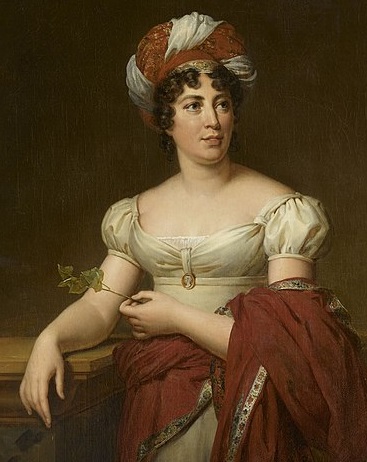
The French Revolution forced Germaine de Stael to flee to her family’s castle near Geneva. There she became the mistress of the regicide Adolph Ribbing, who fled. Nevertheless, Germaine became friends with Adolph’s mother Eva Löwe n – who before the assassination of Gustav III owned a residence in Stockholm, unclearly on Drottninggatan or Blasieholmen. A beauty in her younger days courted by father and son von Fersen, even by Gustav (III.)
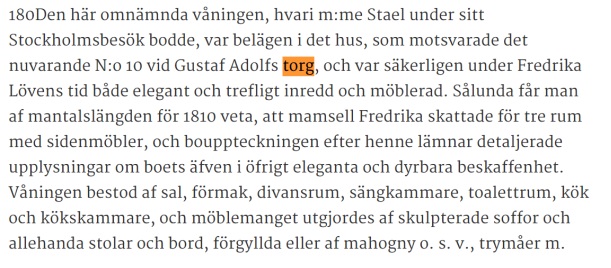
1812-1813. Judging from the text, de Stael lives at Gustav Adolfs torg, diagonally opposite the opera. Where, as in Paris, she holds a salon for a literary and political elite. Perhaps the windows have a view over Norrbro – towards the castle where she often visits Crown Prince Karl Johan Bernadotte, to entice him to fight against Napoleon.
Madame has two children and her newlywed husband, the young lieutenant Jean de Rocca, with her entourage. Also in the entourage is the philosophically inclined writer Wilhelm Schlegel. Both are passionate about romanticism.
In her luggage, de Stael has the manuscript for De l’Allemagne, a text about the German nation that provoked bilious fever in Napoleon. The Baroness (as she also calls herself after Eric Stael von Holstein died) is a literary great in Europe, mainly with the erotically titillating Corinne. A writing that makes early feminism sprout (in Sweden, among others, with Emilie Flygare Carlén and Fredrika Bremer). Although Germaine prefers to socialize with men than without men in the short year she is in Stockholm.
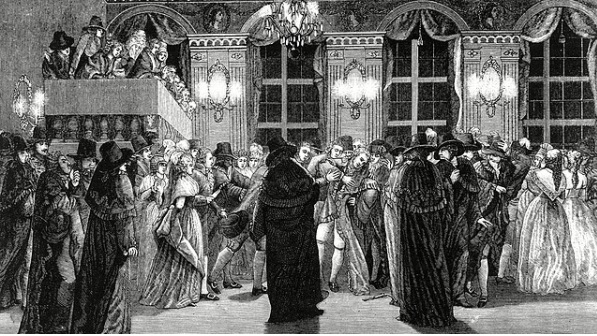
1792. At a masquerade ball, the king is shot behind the scenes of the opera by Captain Jacob Johan Anckarström, accompanied by the conspirators Adolph Ribbing and Claes Horn.
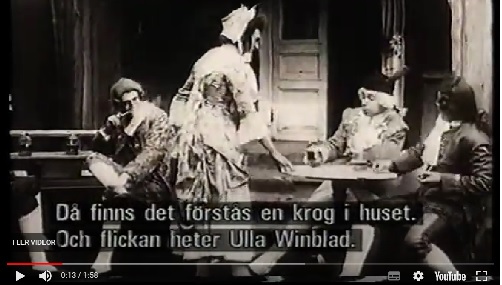
1839. The Stockholm Opera premieres The Postiljonen by Lonjumeau , followed by more operas with librettos written by Adolphe de Leuven . Resident in Paris and son of the murderer Count Adolf Ribbing.


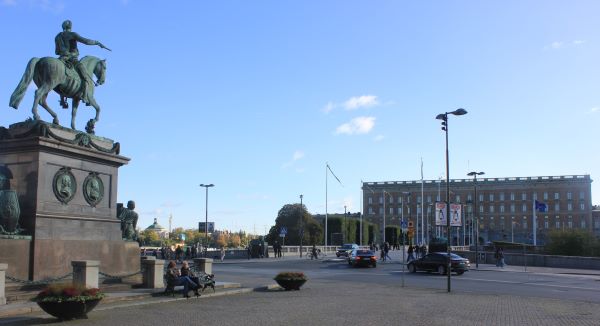
/ By Ingemar Lindmark
